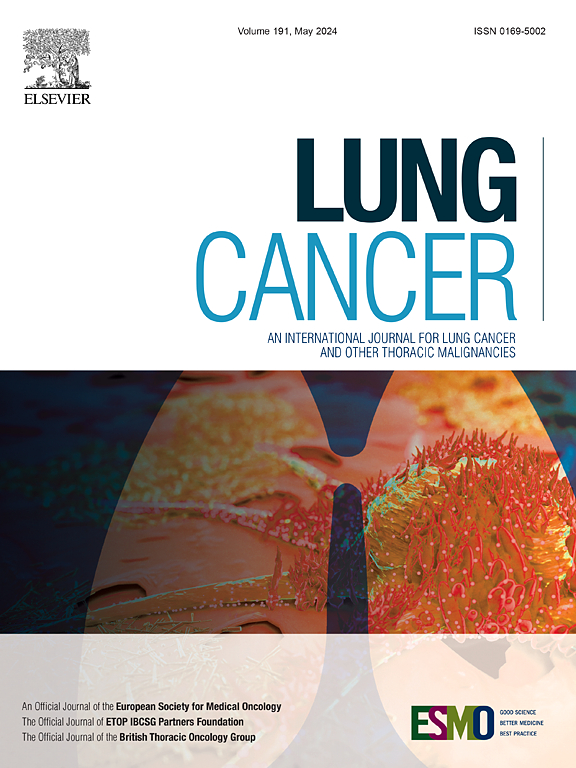Determining the optimal approach to identify osimertinib resistance; the first line osimertinib cohort of the OSIRIS study
IF 4.4
2区 医学
Q1 ONCOLOGY
引用次数: 0
Abstract
Background
Resistance mechanisms (RMs) inevitably develop during osimertinib treatment in EGFR mutation positive (EGFRm+) NSCLC, and may guide subsequent therapy. We hypothesized that a complete RM analysis requires next-generation sequencing (NGS) of tumor tissue and plasma in patients experiencing disease progression (PD) on first-line osimertinib.
Methods
At time of PD during osimertinib treatment, patients underwent plasma and tissue NGS for RM analysis. Plasma was analyzed with AVENIO ctDNA expanded panel, tissue with DNA and RNA NGS following local standards. Successful sequencing was defined by EGFRm identification.
Results
Between February 2020 and January 2024, 150 patients were enrolled. Plasma sequencing was successful in 84 %, tissue sequencing in 94 %, both in 81 % of patients. In total, 159 RMs covered by both modalities were identified, 76 % in tissue, 59 % in plasma. Concordance was 34 %.
In 54 patients, EGFR, MET and/or ERBB2 were amplified. At least one amplification was found in both sources for 17 patients, in tissue only for 25. Median EGFRm variant allele frequency (VAF) in plasma differed between these groups (25.9 vs 3.0 %, P < 0.05).
Conclusions
In case of low EGFRm VAF in plasma, combining tumor and plasma sequencing uncovers additional RMs compared to any single modality. Utilizing both for complete RM assessment is therefore recommended.
Clinicaltrials.gov Identifier: NCT04737382.
确定奥希替尼耐药鉴定的最佳方法;OSIRIS研究的一线奥西替尼队列。
背景:EGFR突变阳性(EGFRm+)非小细胞肺癌在奥西替尼治疗过程中不可避免地出现耐药机制(RMs),并可能指导后续治疗。我们假设完整的RM分析需要对一线使用奥西替尼的疾病进展(PD)患者的肿瘤组织和血浆进行下一代测序(NGS)。方法:在奥西替尼治疗期间PD时,对患者进行血浆和组织NGS进行RM分析。血浆用AVENIO ctDNA扩增板分析,组织DNA和RNA NGS符合当地标准。通过EGFRm鉴定确定测序成功。结果:在2020年2月至2024年1月期间,150名患者入组。血浆测序成功率为84%,组织测序成功率为94%,两者均为81%。两种方式共发现159例RMs, 76%在组织中,59%在血浆中。一致性为34%。在54例患者中,EGFR、MET和/或ERBB2扩增。17例患者在两种来源中至少发现了一种扩增,只有25例患者在组织中发现了扩增。血浆中EGFRm变异等位基因频率(VAF)中位数在两组之间存在差异(25.9% vs 3.0%, P)。结论:在血浆中EGFRm变异等位基因频率较低的情况下,与任何单一模式相比,结合肿瘤和血浆测序发现了额外的RMs。因此,建议使用这两种方法进行完整的RM评估。临床试验:gov标识符:NCT04737382。
本文章由计算机程序翻译,如有差异,请以英文原文为准。
求助全文
约1分钟内获得全文
求助全文
来源期刊

Lung Cancer
医学-呼吸系统
CiteScore
9.40
自引率
3.80%
发文量
407
审稿时长
25 days
期刊介绍:
Lung Cancer is an international publication covering the clinical, translational and basic science of malignancies of the lung and chest region.Original research articles, early reports, review articles, editorials and correspondence covering the prevention, epidemiology and etiology, basic biology, pathology, clinical assessment, surgery, chemotherapy, radiotherapy, combined treatment modalities, other treatment modalities and outcomes of lung cancer are welcome.
 求助内容:
求助内容: 应助结果提醒方式:
应助结果提醒方式:


